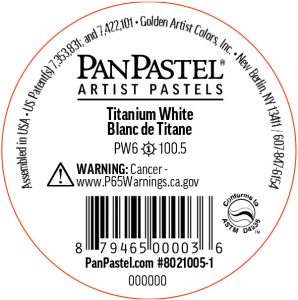All things are poison, and nothing is without poison; the dosage alone makes it so a thing is not a poison. —Paracelsus, 1538
If just joining the community of Golden Artist Colors product line users, one might not know we avoid the term “nontoxic”. It implies an absolute guarantee, and its promise seems in opposition to label statements on many of the color labels stating “WARNING: This product contains a chemical known to the State of California to cause cancer”, or, currently for Europe, “Warning! Hazardous respirable dust may be formed when used. Do not breathe dust.”

A good answer to the “nontoxic” question requires a little more than a “yes”, or “no”. The long answer: PanPastel Colors contain no material in sufficient quantity known to be toxic or injurious to health. Meaning, in accord with United States Federal law, and consistent with the United Nations system of Global Harmonization of hazard identification and communication, the product formulas have been carefully evaluated by an independent toxicologist and, from everything known about the chemical components, the toxicologist has determined that based on their toxicity and concentration in the product, along with the anticipated use of the products, they are not deemed to present an acute or chronic health hazard. Assurance to this is provided on every label with the statement “Conforms to ASTM D 4236”. However, that does not mean the products are without ingredients that have toxicity data associated with them.
In practice, this makes it possible for the California “Prop 65” warning, above, to exist on a label for products that are actually very safe to use. The product may contain one or more components on California’s list of known carcinogens, but not at a concentration or anticipated exposure to the user that would be poisonous, i.e., acutely or chronically toxic. Regardless, the State of California requires us to apply the Warning statements. The components in the PanPastel line which are on the California list are Titanium Dioxide, Carbon Black and Crystalline Silica, all of which make the list in the context of “airborne particles of respirable size”, generally acknowledged to be a particulate size of less than 10 microns, but this is an inexact number. The reality is that PanPastel is a particulate product that can become inhaled during use, but again, “the dose makes the poison”, and we are comfortable with the toxicologist’s assessment of safety, that there is no hazard with anticipated use.
We’ve long advised that breathing any dust or mists generated by use of our products, be avoided as a matter of good chemical hygiene. If a product does indeed have some potential for toxicity, as with airborne cadmium pigments, we do not use them. In example, GOLDEN Fluid and High Flow Acrylic product lines do not contain cadmium pigments in order to avoid the possibility of user exposure from airbrush application. Likewise, cadmium pigments are not used in the PanPastel Colors.
Our most conservative advice remains to avoid breathing dusts from using PanPastel Color, and avoid hand to mouth contact to avoid ingestion. Perhaps work vertically, so there is no need to blow dusts off the work, or consider a simple respirator if there are signs the material is getting inhaled. However, we know work practices vary greatly and exposure to dusts during pastel use is to be expected. Therefore, PanPastel Colors are formulated to be safe with these work practices in mind. For additional Health and Safety considerations you can consult our Safety Data Sheet.
About Ben Gavett
View all posts by Ben Gavett -->Subscribe
Subscribe to the newsletter today!
No related Post


Thank you for this information.
As usual, Golden has our backs with usable information that helps us be more knowledgeable and pro-active in our craft.
The watchwords seem to be “the dosage makes the poison” and indeed we are all unique in that regard. (I used to pull poison ivy up by the roots until I couldn’t. now it’s full clothing and arms length rubber gloves)
The other watchword seems to be “anticipated use.” Again that fall to us users and again Golden arms us with information to aid in decision-making.
Thank you so much for the support. Your observation about sensitization with the Poison Ivy example is an important contribution. For example, our waterborne paints are labeled (European requirement) for the possibility of causing an allergic reaction to users who have been sensitized to the listed preservatives. We also periodically hear from artists with various chemical sensitivities which result in symptomatic reactions to products which normally can be used without ill-effect. So thank you, also, for illuminating that “non-toxic” can also be very related to one’s own susceptibility.
Thank you for sharing!
Crazy I know but what if you wanted to put colored streaks in your hair just till the next shampoo? Would this be safe to do?
Thanks,
Julian
Hello Julian,
Thank you for your question. PanPastels, like any of our artist materials, are neither intended nor recommended for cosmetic use. We are glad you asked, and hope you find a product formulated for the intended use, that will safely create the desired look.